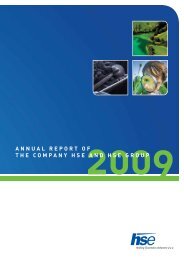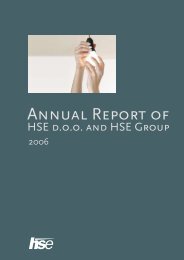WAY UPWARDS - HSE
WAY UPWARDS - HSE
WAY UPWARDS - HSE
You also want an ePaper? Increase the reach of your titles
YUMPU automatically turns print PDFs into web optimized ePapers that Google loves.
90 Annual Report 2011<br />
Quantity risk associated with deviations<br />
from contractual quantities<br />
Quantity risk associated with deviations from<br />
contractual quantities is represented by the difference<br />
between the actually supplied or received<br />
quantities and the projected quantities. The difference<br />
must be additionally purchased or sold in the<br />
market, frequently under less favourable conditions;<br />
similarly, production shortfalls must be covered<br />
with electricity purchases, the market price of which<br />
is usually higher than the contractual price.<br />
In 2011, risks were managed with the following<br />
activities and methods:<br />
• Daily recording of measurements (actual takeover<br />
or production), monitoring of deviations<br />
of actual schedules from the planned, i.e.<br />
contractual, quantities, which provides for daily<br />
monitoring of realised deliveries and subsequent<br />
analysis, by partner, of the risk of non-delivery<br />
or failure to take over;<br />
• Daily analysis of scenarios involving different<br />
hydrology conditions or failure of TPP<br />
generation units (stress testing);<br />
• Daily monitoring of market conditions (prices<br />
of energy products and transmission capacities),<br />
position of the company, and VaR and MtM by<br />
individual groups of transactions with similar<br />
purpose;<br />
Quantity risk associated with<br />
changes in NTC (cross-border<br />
transmission capacities)<br />
Quantity risk associated with changes in crossborder<br />
transfer capacities arises from changes in<br />
permeability of major individual transport routes<br />
(e.g. reduction of daily cross-border transfer capacities<br />
due to wild currents). As a consequence, situations<br />
can arise where obligations from long-term<br />
contracts are not fulfilled, leading to a need to purchase<br />
more expensive energy as replacement from<br />
other sources (countries) and possibility of deviations<br />
in balances.<br />
In 2011, risks were managed with the following<br />
activities and methods:<br />
• Monthly monitoring of legislation (regulations)<br />
by country and the balance of transmission<br />
capacities;<br />
• Monthly scenario analysis of market conditions<br />
given the previous probabilities of events<br />
and subsequently with regard to findings<br />
on limitations to trading quantities between<br />
countries;<br />
• Daily monitoring of the market position at<br />
Group and company-level by country and by<br />
individual groups of transactions with similar<br />
purpose or significance, and monitoring of<br />
published annual, monthly and daily values<br />
of cross-border transmission capacities on<br />
individual borders.<br />
Regulatory risk<br />
Regulatory risks arise from changes in market<br />
rules or legislation in the Slovene and foreign electricity<br />
and CO2 emission coupon markets and affect<br />
the business results of the company/Group. Their<br />
management is the most demanding as it is difficult<br />
to predict, identify and quantify them and prevent or<br />
mitigate their effects. Laws and other regulations in<br />
energetic sector are frequently changed an amended.<br />
Therefore, it is necessary to adequately adapt procedures<br />
and methods related to the management<br />
of regulatory risks. In 2011, risks were managed or<br />
controlled mostly with the following activities and<br />
methods:<br />
• Constant monitoring of development of the<br />
Slovenian and foreign markets for electricity and<br />
other energy products and the CO2 emission<br />
coupons market as well as the associated<br />
regulatory framework, and response to such<br />
changes by adapting the trading strategy;<br />
• Performance of long- and medium-term<br />
scenario analyses in light of the expected<br />
changes to the regulatory framework;<br />
• Continuous reporting and informing about legislative<br />
changes in domestic and local markets<br />
by the domestic and local legal departments;<br />
• Daily monitoring of investment decisions in<br />
the EU energy sector and economic policy, and<br />
adaptation of market measures;<br />
• Adequate responding to propositions of changes<br />
and adopted amendments to legislation.<br />
Methodology risks<br />
Methodology risk is a risk arising from changes<br />
in actual value of individual groups of transactions<br />
due to inappropriate methodology, incorrect modelling<br />
items, modelling errors or incompatible models.<br />
The result is incorrect projection of price dynamics<br />
or inaccurate valuation of products in the market.<br />
In 2011, risks were managed with the following<br />
activities and methods:
















